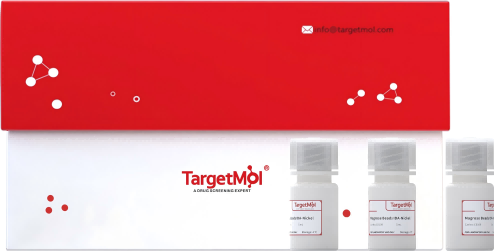- Remove All
 Your shopping cart is currently empty
Your shopping cart is currently empty


His Tag Agarose NTA-Nickel
The product is suitable for purifying His-tagged proteins—such as 6xHis-tag proteins—expressed in various systems, including E. coli, yeast, insect cells, and mammalian expression systems.
| Pack Size | Price | Availability | Quantity |
|---|---|---|---|
| 10 mL | $83 | In Stock | |
| 25 mL | $167 | In Stock | |
| 100 mL | $483 | 7-10 days |
 General Information
General Information
| His Tag Agarose NTA-Nickel | Features |
|---|---|
| Composition | 4% highly cross-linked agarose |
| Particle Size | 45-135 μm |
| Ligand | Nitrilotriacetic Acid(NTA) |
| Chelated Metal Ion | Ni2+ |
| Binding Capacity | >40 mg His-tag Protein |
| Maximum Pressure | 80∽150 cm/h(0.3 MPa, 3 bar) |
| Concentration | 50% (v/v) suspension |
| Storage Solution | 1× PBS(20% ethanol) |
 Product Features
Product Features
- Good stability
- Ligands are not easily detached
- High durability
- Easy to use
 Product Application
Product Application
- Suitable for purifying soluble His-tagged proteins expressed either intracellularly or secreted from bacterial, yeast, insect, or mammalian cells.
- Suitable for purifying denatured proteins (inclusion bodies must be denatured prior to purification).
 Instructions
Instructions
Preparation of Buffer
The following are commonly used buffer compositions for most His-tag protein purification.
Note: It is recommended to filter the buffer using a 0.22 μm or 0.45 μm membrane filter for sterilization before use.
1)Binding Buffer:20 mM Phosphate Buffer,500 mM NaCl,5~50 mM Imidazole,pH7.4.
2)Washing Buffer:20 mM Phosphate Buffer,500 mM NaCl,50~100 mM Imidazole,pH7.4.
3)Elution Buffer:20 mM Phosphate Buffer,500 mM NaCl,500 mM Imidazole,pH7.4.
Protein Sample Processing
1)E. coli, yeast and other intracellular proteins: a) add protease inhibitors (e.g., 1 mM PMSF or C0001 protease inhibitor Cocktail) to the Binding Buffer. b) dilute the expressed cells with an appropriate amount of Binding Buffer. c) resuspend the cells and lyse them by sonication on ice to obtain a crude protein sample. If the sample is too viscous, add an appropriate amount of nuclease and incubate on ice for 30 minutes to degrade nucleic acids. Centrifuge the sample if necessary.
2)Intracellular proteins in animal cells: a) take an appropriate amount of animal cells, wash once with an appropriate amount of PBS, and remove the supernatant. b) resuspend with an appropriate amount of Binding Buffer containing 1% (v/v) Triton X-100 or 1% (v/v) NP-40. c) add protease inhibitors and incubate on ice for 10 minutes to obtain a crude protein sample.
3)Extracellular expression proteins: dilute the extracellular supernatant with an equal volume of Binding Buffer to obtain a crude protein sample.
Purification of Recombinant His-tag Fusion Protein
- Gently resuspend the product and transfer 2 mL of agarose into a column. Equilibrate with 10 mL of Binding Buffer and repeat the equilibration step once.
2)Close the outlet at the bottom of the column and add the His-tagged protein sample into the column. Seal the top of the column with parafilm. Incubate the column on a rotator at room temperature for 1–2 hours, or at 2–8°C for 2–4 hours or overnight.
3)After incubation, open both the top and bottom outlets of the column to allow the supernatant to flow through completely. Collect the flow-through and store at 2–8°C for later analysis.
4)Add 10 mL of Washing Buffer to the column and collect the wash fraction. Store at 2–8°C. Repeat the washing step 4 times.
5)Protein Elution:
a) Standard Elution:
Add 1 mL of Elution Buffer and collect the eluted protein in 1.5 mL centrifuge tubes, collecting 5–10 fractions.
Note: If optimization is needed, gradient elution may be used instead.
b) Gradient Elution:
Elute the protein using Elution Buffers containing different concentrations of imidazole. Collect fractions at each concentration step.
Note: Before storing the target protein, dialysis or ultrafiltration should be performed to remove imidazole and other impurities. Aliquot the purified protein and store at –80°C.
SDS-PAGE Analysis
Analyze the original sample and fractions collected during the purification process (including the flow-through, wash fraction, and elution fraction) by SDS-PAGE to evaluate the purification efficiency.
Regeneration
Nickel ions on agarose typically do not require frequent stripping and recharging. Regeneration should be performed when the agarose color fades significantly or the binding capacity noticeably decreases.
The procedure is as follows:
1)Pack the agarose into an appropriate column.
2)Wash the agarose with 5x bed volumes of deionized water.
3)Strip the nickel ions using 5x bed volumes of 100 mM EDTA solution (pH 8.0).
4)Rinse the agarose with 10x bed volumes of deionized water.
5)Add 5x bed volumes of 0.5 M NaOH solution and allow to stand for 10–15 minutes.
6)Rinse the agarose with deionized water until the pH of the effluent returns to neutral.
7)Reload nickel ions using 3–5x bed volumes of 100 mM NiSO₄solution.
8)Rinse the agarose with 10x bed volumes of deionized water.
Note: The regenerated agarose can be used immediately. For long-term storage, suspend the product in an equal volume of 20% ethanol solution and store at 4–30°C.
 Storage
Storage
Store at 4℃ for 2 years.
 Precautions
Precautions
- Avoid freezing the product. Store in solution to prevent drying.
- Before removing the agarose from the tube, ensure they are evenly suspended by gentle shaking. Handle gently to prevent the bubbles.
- This product is for scientific research use by professionals only and must not be used for clinical diagnosis or treatment, food or drug applications, and must not be stored in residential areas.
- For your safety and health, wear lab coats and disposable gloves during operation.
 Instruction Manual
Instruction Manual
Sci Citations

Copyright © 2015-2025 TargetMol Chemicals Inc. All Rights Reserved.


